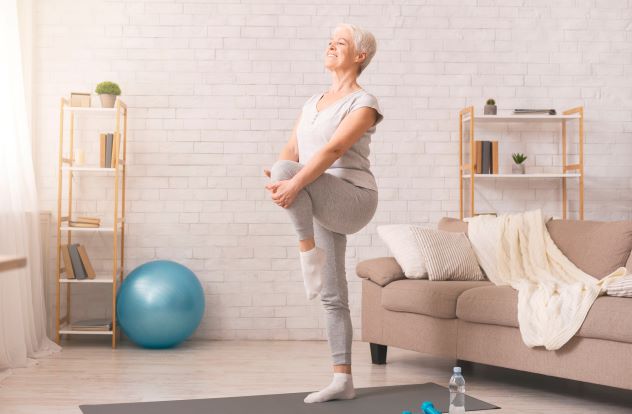Your chances of suffering a fracture from osteoporosis increase with age and if you are female. Many fractures lead to immediate pain. Other fractures go unnoticed at first and slowly lead to increasing pain and disability over time. Falls are a leading cause of fracture in people with osteoporosis. Even a minor fall can fracture a weakened and susceptible bone. This article teaches you how to get started with balance exercises so you don’t have to worry about falling.
A Proven Way to Decrease Your Fear of Falling and Improve Balance
A recent study supported by the International Osteoporosis Foundation and the National Osteoporosis Foundation investigated the effectiveness of exercise in 149 women with osteoporosis. These women were all 65 years and older. All had sustained a previous spine fracture.
Half of the women performed a 12-week exercise program of strength training and balance exercises. These women met twice per week for a one-hour group exercise class. The other half of the research participants performed no exercise for the 12-week study period.
The women who performed the 12 weeks of exercise showed significant improvements in several areas. Balance scores, sit-to-stand time, arm strength, and fear of falling all improved in the exercise group. The group performing no exercise showed no improvement in any of these areas. These results suggest women with osteoporosis benefit from an ongoing exercise program that includes both strength and balance exercises.
3 Simple Balance Exercises for Osteoporosis to Help You Start
Balance exercise is performed along with strength training. Squats, step-ups, and lunges are great exercises to build strength and bone density and improve your balance. However, you also want to work on exercises that are specific to balance. These should be done at least 2 to 3 days per week.
We recommend you start with static balance exercises. These are exercises where you are standing in one place. It is easy to do these near a chair or wall just in case you become unbalanced. Examples are single-leg standing or standing in tandem with 1 foot in front of the other. Perform these exercises with at least 10-second holds. Work up to 30-second holds for at least 3 repetitions on each side.
After you master the static balance exercise, start moving a little more. Dynamic balance exercises are more challenging and typical of what you will encounter during everyday activities. An example is walking heel to toe in tandem. Also, stepping over objects is a simple but challenging balance exercise you can do in your home. Perform 10 steps in each direction for at least 2 to 3 sets.
Do Balance Exercises Anytime and Anywhere
You do not have to do balance exercises at a gym or at any dedicated time of day. We recommend you incorporate balance exercises into your daily activities. For example, balance for 10 to 30 seconds while waiting for the kettle to boil, or cooking. During television commercials, stand up and practice tandem walking. Try different things and stick with what works for you.
See Your Physical Therapist for a Personalized Exercise Program
Combining weight-bearing strength training with balance exercises will get you the best results. You may have difficulty getting started. This is normal especially if you have some fears about falling.
Many people we work with prefer to get started with the help of their physical therapist. This is a safer approach for a lot of people who have fallen in the past. Your therapist will guide you along until you are ready to exercise on your own. Contact us for help developing the program that is best for your abilities and goals.

